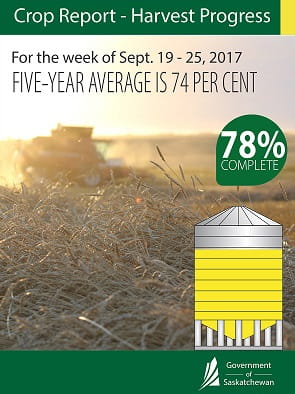Released on September 28, 2017
Wet and cool weather delayed harvest for most producers this past week, according to Saskatchewan Agriculture’s Weekly Crop Report. Seventy-eight per cent of the crop is now in the bin, slightly up from 75 per cent last week. Harvest progress remains ahead of the five year (2012-2016) average of 74 per cent for this time of year. Fifteen per cent of the crop is swathed or ready to straight-cut. Many producers expect to be back in the field when warmer weather returns and crops can dry sufficiently.
Harvest is most advanced in the southwestern region, where 92 per cent of the crop is now combined. The southeastern region has 88 per cent combined, the west-central region 81 per cent and the east-central region 77 per cent. The northeastern region has 53 per cent combined, while the northwestern region has 48 per cent combined.
Ninety-four per cent of mustard, 91 per cent of durum, 88 per cent of chickpeas, 84 per cent of barley, 77 per cent of spring wheat, 68 per cent of canola and oats, 66 per cent of canaryseed, 37 per cent of flax and 18 per cent of soybeans have now been combined. Twenty-seven per cent of canola is swathed or ready to straight-cut.
Although the rain was welcomed by many producers in the drier areas of the province, those in the central and northern areas need warm and dry weather soon so that harvest can resume. Rainfall this past week ranged from nil to 36 mm in the Debden and Hafford areas.

Topsoil moisture conditions continue to improve with the recent rainfall, although the subsoil will need significant new moisture to replenish what has been lost to the hot and dry weather. Across the province, topsoil moisture on cropland is rated as 29 per cent adequate, 36 per cent short and 35 per cent very short. Hay land and pasture topsoil moisture is rated as 22 per cent adequate, 34 per cent short and 44 per cent very short.
The extended period of hot and dry conditions this summer has negatively affected production, particularly in the southern and central regions. Canola crops suffered the most, as much of the crop was in full flowering during the hottest time of the season. There are indications that yield has been reduced by as much as 75 per cent in some areas.
Soybean crops have been slow to mature and there are reports of pods not filling completely. Many lentil and cereal crops were unable to fill properly as they ran out of moisture much earlier than normal. Lighter bushel weights and smaller seeds have resulted. There are also reports of reduced protein content in cereal crops.
While yields have been directly affected by the extremely dry conditions, crop quality has been good to excellent with minimal disease issues.
The majority of crop damage this past week was due to wildlife, strong winds, frost and lack of moisture. Pastures and hay land have suffered greatly from the lack of moisture and will need significant rainfall.
Producers are busy combining, completing fall field work, moving cattle and hauling bales.
SaskPower reports there were four reported incidents of farm machinery coming in contact with power equipment last week. The total number of incidents reported in September now sits at 21. Producers are urged to be especially careful when using equipment around power lines. Safety information is available at www.saskpower.com/safety.
For a complete copy of the crop report, visit http://www.publications.gov.sk.ca/redirect.cfm?p=87447&i=104101.
Follow the 2017 Crop Report on Twitter at @SKAgriculture.
-30-
For more information, contact:
Shannon Friesen
Agriculture
Moose Jaw
Phone: 306-694-3592
Email: shannon.friesen@gov.sk.ca

